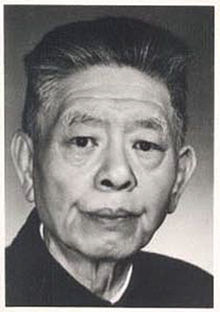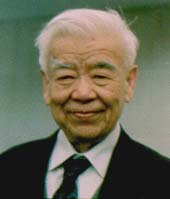
Rao Yutai (Chinese :饒毓泰; December 1, 1891 – October 16, 1968) was a Chinese physicist, one of the founders of modern physics in China. He was a founding member of Academia Sinica in 1948 and of the Chinese Academy of Sciences in 1955.

Rao Yutai (Chinese :饒毓泰; December 1, 1891 – October 16, 1968) was a Chinese physicist, one of the founders of modern physics in China. He was a founding member of Academia Sinica in 1948 and of the Chinese Academy of Sciences in 1955.
Rao was born in Linchuan, Jiangxi, Qing Empire in December 1891. [1] His father was a government officer in Qing Dynasty. He studied Chinese classical literature in childhood. In 1905, he went to study in a high school in Shanghai. Dr. Hu Shih taught his English.[ citation needed ]
In 1913, Rao went to study in the United States, sponsored by the government. He was first recruited to the University of California, and moved to the University of Chicago. He obtained his bachelor in physics in winter 1917. He enrolled in the graduate school at Harvard University in 1918. Later, he moved to Yale University and then Princeton University. He received his master's degree from Princeton in 1921, and his doctorate in 1922. His dissertation was on the emission efficiency of low-pressure electrical arcs, under the supervision of K.T. Compton. [1]
He returned to China and was recruited to Nankai University, where he founded the department of physics and served as chair. [1] His notable students include Wu Ta-You, Wu Daren, Yung-huai Kuo, Jiang Zehan, Ma Shijun, Shen Youzhen, Shiing-shen Chern and Zheng Huazhi.[ citation needed ]
In 1929, Rao went to do research at the University of Leipzig in Germany. He returned in 1932 and became a fellow in the physics institute of the Peking Research Institute. He later became the chair of the physics department at Peking University, and was promoted to Dean of the school of science in 1935. He was the chair of the physics department at the National Southwestern Associated University during the Sino-Japanese War. From 1944 to 1947, he studied the molecular spectra in the United States, in collaboration with A. H. Nielsen. [1]
In 1949, Rao chose to stay at Peking University, upon the establishment of the People's Republic of China. He continued to serve as dean and chair of physics until 1951. He was elected as member of the Chinese Academy of Sciences in 1955. [1]
Rao was severely persecuted in Cultural Revolution. He committed suicide on the University campus on October 16, 1968. He was posthumously rehabilitated in 1978. [1] His descendants would be found in the US and Sweden.
In 2000, the Chinese Physical Society established five prizes, in recognition of five pioneers of modern physics in China. The Rao Yutai Prize is awarded to physicists in Optics, Acoustics, Atomic and Molecular physics. [1]

Shiing-Shen Chern was a Chinese American mathematician and poet. He made fundamental contributions to differential geometry and topology. He has been called the "father of modern differential geometry" and is widely regarded as a leader in geometry and one of the greatest mathematicians of the twentieth century, winning numerous awards and recognition including the Wolf Prize and the inaugural Shaw Prize. In memory of Shiing-Shen Chern, the International Mathematical Union established the Chern Medal in 2010 to recognize "an individual whose accomplishments warrant the highest level of recognition for outstanding achievements in the field of mathematics".

Paul Ching Wu Chu is a Chinese-American physicist specializing in superconductivity, magnetism, and dielectrics. He is a professor of physics and T.L.L. Temple Chair of Science in the Physics Department at the University of Houston College of Natural Sciences and Mathematics. He was the president of the Hong Kong University of Science and Technology from 2001 to 2009. In 1987, he was one of the first scientists to demonstrate high-temperature superconductivity.

Daniel Chee Tsui is a Chinese-born American physicist. He is currently serving as the Professor of Electrical Engineering, emeritus, at Princeton University. Tsui's areas of research include electrical properties of thin films and microstructures of semiconductors and solid-state physics.

Wu Ta-You was a Chinese physicist and writer who worked in the United States, Canada, mainland China and Taiwan. He has been called the Father of Chinese Physics.
Xi-Cheng Zhang is a Chinese-born American physicist, currently serving as the Parker Givens Chair of Optics at the University of Rochester, and the director of the Institute of Optics. He is also the Chairman of the Board and President of Zomega Terahertz Corporation.

Sir Peter Leonard Knight is a British physicist, professor of quantum optics and senior research investigator at Imperial College London, and principal of the Kavli Royal Society International Centre. He is a leading academic in the field of quantum optics and is the recipient of several major awards including the Royal Medal from the Royal Society and the Thomas Young Medal and Prize from the Institute of Physics. He is a former president of the Institute of Physics and Optica, the first non North American-based person to take the position.
Chen Jiangong, or Jian-gong Chen, was a Chinese mathematician. He was a pioneer of modern Chinese mathematics. He was the dean of the Department of Mathematics, National Chekiang University, and a founding academician the Chinese Academy of Sciences.
Peng Huanwu was a Chinese physicist. He was a member of Chinese Academy of Sciences (CAS), and a leader of Chinese nuclear weaponry projects.
Chen Jia'er is a Chinese nuclear physicist, an accelerator physicist and an academician of the Chinese Academy of Sciences (CAS).

Hu Ning was a Chinese physicist and writer.

Anthony Michael Johnson is an American experimental physicist, a professor of physics, and a professor of computer science and electrical engineering at the University of Maryland, Baltimore County (UMBC). He is the director of the Center for Advanced Studies in Photonics Research (CASPR), also situated on campus at UMBC. Since his election to the 2002 term as president of the Optical Society, formerly the Optical Society of America, Johnson has the distinction of being the first and only African-American president to date. Johnson's research interests include the ultrafast photophysics and nonlinear optical properties of bulk, nanostructured, and quantum well semiconductor structures, ultrashort pulse propagation in fibers and high-speed lightwave systems. His research has helped to better understand processes that occur in ultrafast time frames of 1 quadrillionth of a second. Ultrashort pulses of light have been used to address technical and logistical challenges in medicine, telecommunications, homeland security, and have many other applications that enhance contemporary life.
The Wu Chinese people, also known as Wuyue people, Jiang-Zhe people (江浙民系) or San Kiang (三江), are a major subgroup of the Han Chinese. They are a Wu Chinese-speaking people who hail from southern Jiangsu Province, the entirety of the city of Shanghai and all of Zhejiang Province, as well as smaller populations in Xuancheng prefecture-level city in southern Anhui Province, Shangrao, Guangfeng and Yushan counties of northeastern Jiangxi Province and some parts of Pucheng County in northern Fujian Province.

Ye Qisun, also named Ye Hongjuan (叶鸿眷), was a Chinese physicist and one of the founders of modern physics in China.
Yuen-Ron Shen is a Chinese physicist. He is a professor emeritus of physics at the University of California, Berkeley, known for his work on non-linear optics. He was born in Shanghai and graduated from National Taiwan University. He received his Ph.D. in Applied Physics from Harvard under physicist and Nobel Laureate Nicolaas Bloembergen in 1963, and joined the department of physics at Berkeley in 1964. In the early years, Shen was probably best known for his work on self-focusing and filament propagation of laser beams in materials. These fundamental studies enabled the creation of ultrafast supercontinuum light sources. In the 1970s and 1980s, he collaborated with Yuan T. Lee on the study of multiphoton dissociation of molecular clusters. The molecular-beam photofragmentation translational spectroscopy that they developed has clarified much of the initial confusion concerning the dynamics of infrared multiphoton dissociation processes. In the 1980s and 1990s, Shen developed various nonlinear optics methods for the study of material surfaces and interfaces. Among these techniques, second-harmonic generation and sum frequency generation spectroscopy are best known and now widely used by scientists from various fields. He has collaborated with Gabor Somorjai on the use of the technique of Sum Frequency Generation Spectroscopy to study catalyst surfaces. He is the author of the book The Principles of Nonlinear Optics. Shen belongs to the prolific J. J. Thomson academic lineage tree. Currently, Shen works in U. C. Berkeley and Fudan University in Shanghai.
Zhou Tongqing, also known as Tung-Ching Chow, was a Chinese optical physicist. After earning his Ph.D. from Princeton University, he taught at Peking University, National Central University, Shanghai Jiao Tong University, and Fudan University. He led the development of China's first X-ray tube in 1953 and was elected a founding member of the Chinese Academy of Sciences in 1955. His research was disrupted when he was subject to severe persecution during the Anti-Rightist Campaign and the Cultural Revolution. Although later politically rehabilitated, he was plagued by poor health for the rest of his life.
Xu Xurong was a Chinese physicist, and an academician of the Chinese Academy of Sciences. He was a delegate to the 12th National People's Congress.
Kuang Yuping is a Chinese physicist and professor at Tsinghua University. He was awarded the 1989 Wu Youxun Prize in Physics.